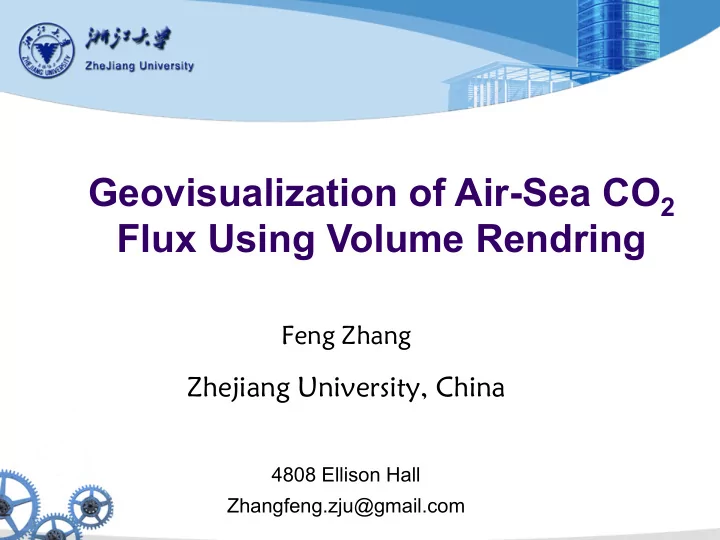

Geovisualization of Air-Sea CO 2 Flux Using Volume Rendring Feng Zhang Zhejiang University, China 4808 Ellison Hall Zhangfeng.zju@gmail.com
Human impacts on the carbon cycle are the most important cause of climate change.
About 26% of the total emissions from human activities , accumulated in the Ocean. The ocean sink is estimated to have removed 29% of total emissions.
Ocean remote sensing used to estimate the air-sea CO2 flux and carbon budget l Satellite ocean color assessment of air-sea fluxes of CO2 in a river-dominated coastal margin (Lohrenz, S.E., Cai, W.-J., 2006 )
A series of CO2 flux images turns display ArcGlobe ArcScence
spatio-temporal visualization method for air-sea CO 2 flux Source: Yellow Bubble rise from the deep sea to the air, larger and larger burst in the air Sinks: Blue Bubble down from the air to the deep sea, smaller and smaller to disappear
Show the ocean carbon source and sinks l Research on 3D spatio-temperal visualization of air-sea CO2 fluxes. Journal of Zhejiang University. Sciences Edition 38, 229-233 (2010)
• Animation not fluent The size and count of bubble more decided by the grid size. It can’t reflect the spatial distribution Research on 3D spatio-temperal visualization of air-sea CO2 fluxes. Journal of Zhejiang University. Sciences Edition 38, 229-233
A new way l Refine the grid size --- à overload computation l Speed up the movement of the Bubble
A new way l Refine the grid size --- à overload computation l Speed up the movement of the Bubble l Slow l More slowly l Too too slowly
A new way l Refine the grid size --- à overload computation l Speed up the movement of the Bubble l air-sea CO2 flux products are constructed as particle systems l volume rendering works efficiently by GPU acceleration l Large data are loaded in parallel and on demand for real-time visualization
spatio-temporal dynamics of carbon sinks and sources • The air-sea carbon budget and accumulating process • Present distribution pattern and variation of CO 2 flux are expressed by color changes • A GPU-based direct volume rendering using half-angle slicing • Visualize the release or absorb CO 2 gas with shadow effects. • Generate four-dimensional (4D) data from satellite-derived air-sea CO 2 flux products • An out-of-core scheduling strategy for on- the-fly rendering of time series of satellite data
Recommend
More recommend